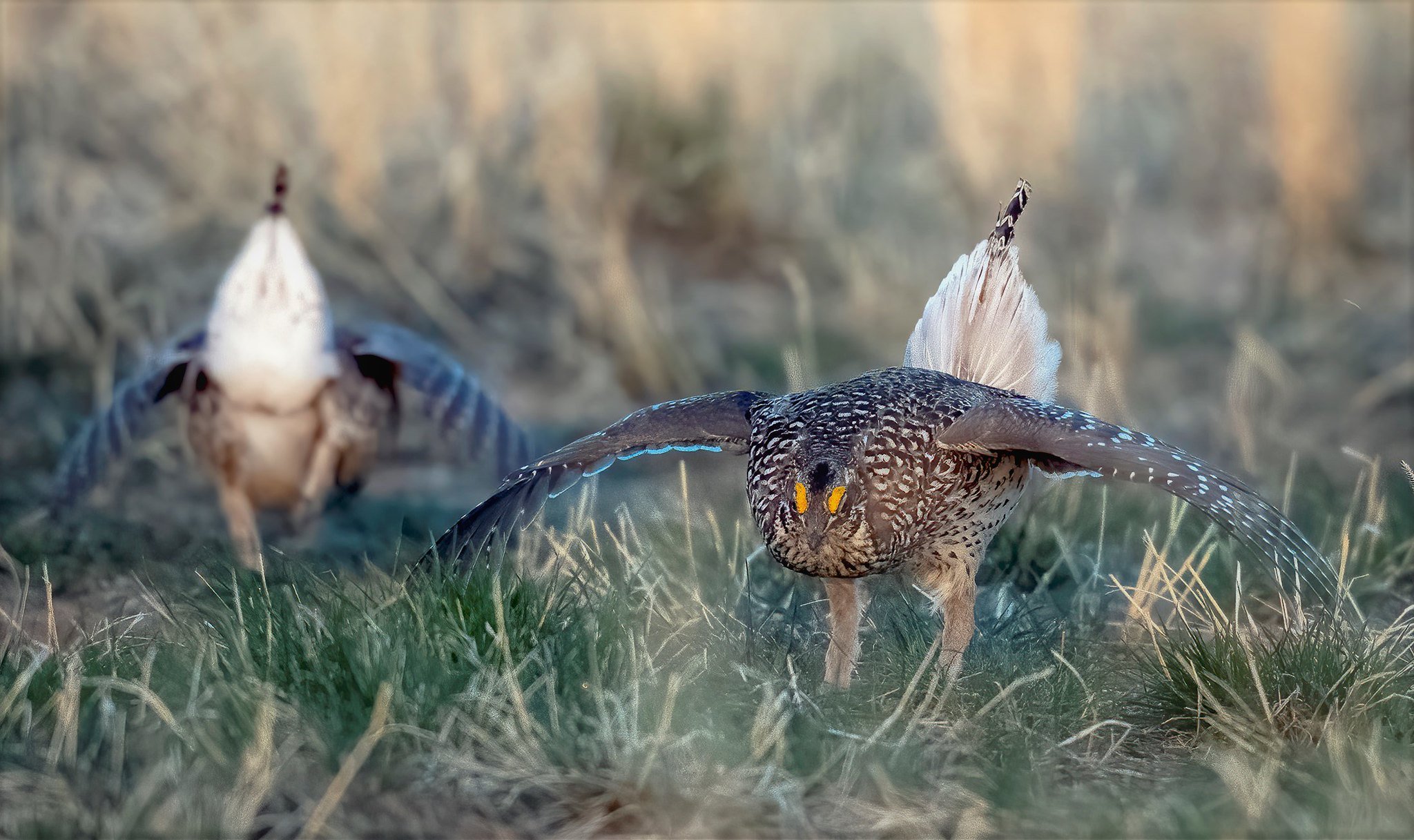November 17, 2023 Update: Our staff and volunteers provided comments and feedback to the WDNR on the Sharp-tailed Grouse Management Plan. Read those comments here.
Sharp-tailed Grouse, by Andy Reago & Chrissy McClarren
You might be surprised. First: to the bird and its presence in Wisconsin.
Please use this link and then click on the DNR draft master plan. In about 70 mostly well-written and easy to read pages, you'll learn just about everything we know about Wisconsin's Sharp-tailed Grouse, including their present status and possible futures.
The sharptail once called all of Wisconsin home, along with much of the upper Midwest and the West east of the Rockies. Its range and numbers have significantly diminished. In Wisconsin, its strongholds are the barrens of Northwest Wisconsin and it faces a real danger of extirpation over the next five decades.
Sharp-tailed Grouse dance by Doug Greenberg FCC
Like all the prairie grouse, males dance for mating opportunities in small areas called leks. Those early morning rituals have fascinated human inhabitants of this area for millenia. The continued existence of the sharptail is important to Wisconsin's Chippewa bands and people travel from hundreds of miles to watch the birds in the spring.
Another group travels hundreds of miles in the late summer and early fall to experience the birds in another way. These are dog trainers who train their pointers and setters on sharptails. Another reason to read the plan is to read concise, accurate descriptions of the reasons these folks bring their dogs to a couple of the large public areas with the grouse. By the way, all hunting for sharptails has been closed for five years and will be, in my judgment, for the foreseeable future. Again, in my opinion, a heartening aspect of the draft is its report on the hunters' and trainers' attitudes toward these birds. They value them highly and, while some would welcome the chance to hunt them again, the unanimous view was to do so only when the populations were at a large, stable, and sustainable enough level so that hunting would not threaten the birds existing and flourishing in Wisconsin.
Sharp-tailed Grouse dance on lek by Rick Bohn / USFWS Mountain-Prairie
The reason for the dwindling numbers of sharptails is the drastic loss of habitat, in particular the loss of barrens and associated habitats throughout the state, but especially in the north. Another reason to read the draft is its discussion of sharptail mortality, including predation. Often when the numbers of a highly valued game species decline, control of predators emerges as one of the ways to help that species out. In the case of sharptails, that will most probably not be effective.
The best reason to read the draft and support its adoption by the WDNR is that it offers real hope for the birds. With a restoration and maintenance of enough habitat in northwest Wisconsin sharptails can recover to healthy, secure numbers—not the abundance of the past but enough for the grouse to be a key part of healthy barrens habitat (oh yeah—the plan also describes what the barrens are and what they need to be healthy). And finally we come to the contributions some of our Bird Alliance members and staff have made to sharptail conservation and this plan, which is key to the birds' survival.
Jim Shurts, a former member of our Board of Directors and longtime member of this organization (4 decades!), has been one of the most ardent sharptail conservationists in Wisconsin for many years. He has been joined by Mark Martin and Sue Foote-Martin, Goose Pond Sanctuary resident managers who have long championed, both personally and professionally, some of the barrens vital for sharptails.
Sharp-tailed Grouse in barrens by Rick Bohn / USFWS Mountain-Prairie
In addition to the good efforts of these folks, sharptails needed a combination of research and detailed and implementable planning to make the expansion of their crucial habitat feasible. That research and those plans were created at UW-Madison. They call for and map a series of corridors or "stepping stones," areas of habitat that connect the larger barrens. These links will enable sharptails to find regenerated barrens and gradually expand their range and possibly improve their genetic diversity. The draft master plan makes it abundantly clear that this corridor plan is the foundation of any real hope for Wisconsin sharptails. A team of UW researchers created that plan. Its principal author was a young, skilled and dedicated ornithologist that you might recognize. Drum roll, please: our very own Executive Director, Matt Reetz.
WAY TO GO, MATT.
He will probably be embarrassed a bit by this blog but I think our members need to know that our Bird Alliance has a skilled ornithologist as our Executive Director. Those professional qualities and achievements are not necessarily the most important he brings to the job, but our organization often has to be sure we are acting on behalf of birds with the best scientific knowledge and management practices in mind. Matt brings that capacity to BBA.
Southern Wisconsin Bird Alliance and Sharp-tailed Grouse have one thing in common: we're lucky Matt Reetz is part of our lives.
Topf Wells, volunteer and advocacy committee







